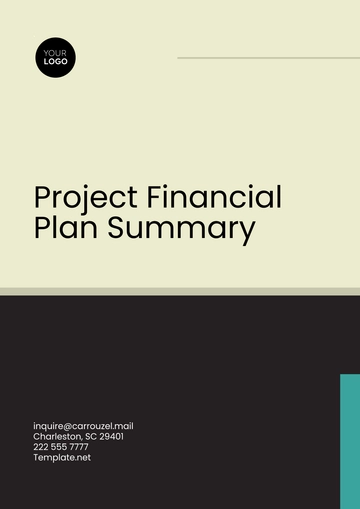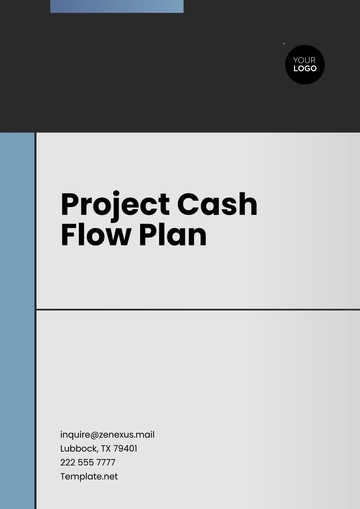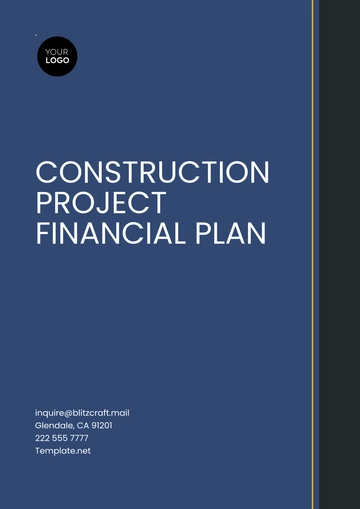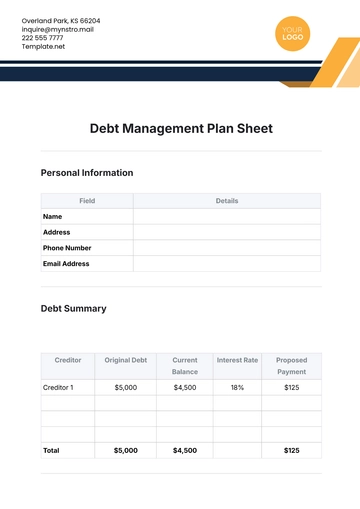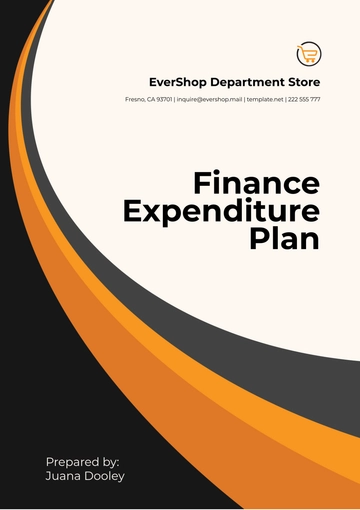Free Financial Plan Outline

Written by: [Your Name]
I. Executive Summary
The following financial plan outlines strategies for managing company finances and planning for growth for [Your Company Name]. It encompasses budgeting for various departments, expense control measures, and cash flow management strategies.
II. Company Overview
[Your Company Name] is a small business specializing in comprehensive financial planning and wealth management services. Established in 2050, we have been serving individuals and businesses nationwide with personalized financial solutions. Our commitment to integrity, innovation, and client satisfaction has enabled us to grow our client base and expand our operations steadily.
III. Financial Goals
A. Short-term Goals
Increase monthly revenue by 15% within the next 12 months.
Reduce operating expenses by $50,000 by the end of 2057.
Improve cash flow by implementing efficient invoicing and payment processing systems.
B. Long-term Goals
Expand market reach to international clients by 2060.
Achieve a sustainable growth rate of 10% annually.
Establish a financial reserve equivalent to 20% of annual revenue for emergency funds and investment opportunities by 2065
IV. Financial Analysis
A. Revenue Projection
Year | Projected Revenue ($) |
|---|---|
2055 | $1,500,000 |
2056 | $1,725,000 |
2057 | $1,983,750 |
B. Expense Breakdown
Category | Budget Allocation ($) | Actual Expenses ($) |
|---|---|---|
Personnel | $600,000 | $550,000 |
Marketing | $200,000 | $175,000 |
Operations | $300,000 | $280,000 |
Technology | $150,000 | $145,000 |
Miscellaneous | $50,000 | $45,000 |
Total Expenses | $1,300,000 | $1,195,000 |
Net Income (Loss) | $200,000 | $230,000 |
V. Financial Strategies
Budget Allocation: Review and adjust departmental budgets quarterly to ensure alignment with company goals and financial performance.
Expense Control: Implement cost-saving measures such as negotiating vendor contracts, optimizing inventory levels, and leveraging technology for efficiency.
Cash Flow Management: Monitor cash flow regularly and implement strategies such as invoice factoring, early payment discounts, and delayed vendor payments to maintain healthy cash reserves.
VI. Investment Strategy
Short-term Investments: Allocate 20% of excess cash reserves to low-risk, short-term investment vehicles such as money market accounts or treasury bills.
Long-term Investments: Diversify investment portfolio by allocating 60% of funds to stocks, bonds, and real estate investment trusts (REITs) for long-term growth and wealth preservation.
Risk Management: Conduct regular risk assessments and adjust investment strategy accordingly to minimize exposure to market volatility and economic uncertainties.
VII. Financing Plan
Debt Management: Evaluate existing debt obligations and explore refinancing options to lower interest rates and extend repayment terms, if beneficial.
Equity Financing: Seek opportunities for equity financing through venture capital, angel investors, or crowdfunding platforms to support expansion initiatives and strategic investments.
Alternative Funding: Explore alternative funding sources such as government grants, business incubators, and peer-to-peer lending to supplement traditional financing options and fuel innovation.
VIII. Conclusion
By adhering to the outlined financial strategies and goals, [Your Company Name] aims to achieve sustainable growth while maintaining financial stability. Regular monitoring and adjustments will be made to ensure the financial plan remains aligned with the evolving needs of the business.
For more information, please contact:
[Your Name]
[Your Email]
[Your Company Number]
[Your Company Address]
- 100% Customizable, free editor
- Access 1 Million+ Templates, photo’s & graphics
- Download or share as a template
- Click and replace photos, graphics, text, backgrounds
- Resize, crop, AI write & more
- Access advanced editor
Discover the ultimate tool for financial foresight with Template.net's Financial Plan Template. Crafted for precision and ease, this editable and customizable gem empowers you to sculpt your financial destiny effortlessly. Seamlessly editable in our Ai Editor Tool, it's your passport to a future defined by prosperity. Unlock your financial potential today with Template.net's Financial Plan Template.
You may also like
- Finance Plan
- Construction Plan
- Sales Plan
- Development Plan
- Career Plan
- Budget Plan
- HR Plan
- Education Plan
- Transition Plan
- Work Plan
- Training Plan
- Communication Plan
- Operation Plan
- Health And Safety Plan
- Strategy Plan
- Professional Development Plan
- Advertising Plan
- Risk Management Plan
- Restaurant Plan
- School Plan
- Nursing Home Patient Care Plan
- Nursing Care Plan
- Plan Event
- Startup Plan
- Social Media Plan
- Staffing Plan
- Annual Plan
- Content Plan
- Payment Plan
- Implementation Plan
- Hotel Plan
- Workout Plan
- Accounting Plan
- Campaign Plan
- Essay Plan
- 30 60 90 Day Plan
- Research Plan
- Recruitment Plan
- 90 Day Plan
- Quarterly Plan
- Emergency Plan
- 5 Year Plan
- Gym Plan
- Personal Plan
- IT and Software Plan
- Treatment Plan
- Real Estate Plan
- Law Firm Plan
- Healthcare Plan
- Improvement Plan
- Media Plan
- 5 Year Business Plan
- Learning Plan
- Marketing Campaign Plan
- Travel Agency Plan
- Cleaning Services Plan
- Interior Design Plan
- Performance Plan
- PR Plan
- Birth Plan
- Life Plan
- SEO Plan
- Disaster Recovery Plan
- Continuity Plan
- Launch Plan
- Legal Plan
- Behavior Plan
- Performance Improvement Plan
- Salon Plan
- Security Plan
- Security Management Plan
- Employee Development Plan
- Quality Plan
- Service Improvement Plan
- Growth Plan
- Incident Response Plan
- Basketball Plan
- Emergency Action Plan
- Product Launch Plan
- Spa Plan
- Employee Training Plan
- Data Analysis Plan
- Employee Action Plan
- Territory Plan
- Audit Plan
- Classroom Plan
- Activity Plan
- Parenting Plan
- Care Plan
- Project Execution Plan
- Exercise Plan
- Internship Plan
- Software Development Plan
- Continuous Improvement Plan
- Leave Plan
- 90 Day Sales Plan
- Advertising Agency Plan
- Employee Transition Plan
- Smart Action Plan
- Workplace Safety Plan
- Behavior Change Plan
- Contingency Plan
- Continuity of Operations Plan
- Health Plan
- Quality Control Plan
- Self Plan
- Sports Development Plan
- Change Management Plan
- Ecommerce Plan
- Personal Financial Plan
- Process Improvement Plan
- 30-60-90 Day Sales Plan
- Crisis Management Plan
- Engagement Plan
- Execution Plan
- Pandemic Plan
- Quality Assurance Plan
- Service Continuity Plan
- Agile Project Plan
- Fundraising Plan
- Job Transition Plan
- Asset Maintenance Plan
- Maintenance Plan
- Software Test Plan
- Staff Training and Development Plan
- 3 Year Plan
- Brand Activation Plan
- Release Plan
- Resource Plan
- Risk Mitigation Plan
- Teacher Plan
- 30 60 90 Day Plan for New Manager
- Food Safety Plan
- Food Truck Plan
- Hiring Plan
- Quality Management Plan
- Wellness Plan
- Behavior Intervention Plan
- Bonus Plan
- Investment Plan
- Maternity Leave Plan
- Pandemic Response Plan
- Succession Planning
- Coaching Plan
- Configuration Management Plan
- Remote Work Plan
- Self Care Plan
- Teaching Plan
- 100-Day Plan
- HACCP Plan
- Student Plan
- Sustainability Plan
- 30 60 90 Day Plan for Interview
- Access Plan
- Site Specific Safety Plan

